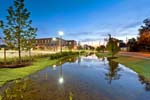
|

|
|
Home Site Search Contact Us Subscribe
|
|
|
Q&A with James Anderson, LEED AP re: Low Impact Development LID is an alternative, cost-effective method for those who want to be sensitive to sustainability, but lack the resources to pursue LEED certification. By ArchNewsNow January 11, 2011 Low Impact Development (LID) is a new way of thinking about an old and established system – a concept or strategy that is catching on with young architects and engineers around the country. The old concept of using ditches on the street for drainage and runoff is something we grew up with. They weren’t much to look at, but they served a purpose. Today, LID utilizes that same concept but applies an aesthetic element that enhances the environment both visually and economically. It represents a return to the Main Street concept of development. It is both a journey and an experience rather than just a focus on concrete and buildings. As a concept, LID attempts to emphasize sustainability and is a way to develop new projects without greatly impacting the natural surrounding environment.
While green design/building – often associated exclusively with LEED certification – is currently the rage, the cost-prohibitive aspect often forces many away from the process. LID is an alternative, cost-effective method right from the beginning – perhaps more properly described as a philosophy or way of thinking. Those who want to be sensitive to sustainability, but lack the resources to pursue LEED certification, now have an alternative in designing according to LID philosophy.
When designing with this concept, architects, engineers, and designers work to create an experience which strays from utilitarian design and focuses on engaging the streetscape for both pedestrians and area businesses. For example, in January 2010, Llewellyn-Davies Sahni, a Houston architecture and design firm, participated in the Houston Land/Water Sustainability Forum design competition for the Bastrop Promenade, an area of mixed-use development in East Downtown Houston near the future Houston Dynamo Stadium (the city’s Major League Soccer franchise). Though the blocks adjacent to the promenade are a high-traffic retail and residential area, the firm developed it without the use of detention ponds or basins. Instead, using LID, they incorporated into the design a system that implemented bioretention cells, swales, rain gardens, and subsurface stormwater harvesting tanks for a more sustainable approach.
James Anderson, LEED AP, a designer with Llewellyn-Davies Sahni, is an enthusiastic promoter and practitioner of the LID concept. Here, Anderson shares his thoughts and experiences with LID, and the philosophies and alternative thinking that often go along with the process.
Q: What is low impact development?
JA: Low impact development (LID) is a term used to describe a land planning and engineering design approach to managing stormwater runoff. LID emphasizes conservation and use of on-site natural features to protect water quality. This approach implements engineered, small-scale hydrologic controls to replicate the pre-development hydrologic regime of watersheds through infiltrating, filtering, storing, evaporating, and detaining runoff close to its source.
Q: Where did you first encounter the idea of LID and what attracted you to the concept?
JA: I was first introduced to LID by a design competition sponsored by the Houston Land/Water Sustainability Forum. It was focused on a 15-acre area in East Downtown Houston. The notion of environmental stewardship was what initially attracted me to it, but the financial and possible social aspects made it all the more attractive. The competition made us focus on creating a usable public space while applying LID design strategies.
Q: What factors do you need to consider in designing according to LID?
JA: LID practices should work on a site-by-site basis. Each site's land use, hydrology, soil type, climate and rainfall patterns should be taken into account when designing with LID in mind. There are several variations on LID practices, so all of them may not be suitable for a given site. However, many of them are practical for retrofit or site renovation projects, as well as for new construction. Frequently used practices include: · bioretention cells, also known as rain gardens · cisterns and rain barrels · green roofs · pervious concrete or permeable paving · bioswales · manufactured (proprietary) devices that capture pollutants and/or aid in on-site infiltration
Q: Does designing with LID effect the overall infrastructure of a project?
JA: LID has shown that it will decrease the amount of infrastructure, and therefore capital, required for project development. Traditional pipe and pond requires piping to carry away the stormwater, and either a detention area on site or impact fee payment for the project’s added burden to the infrastructure.
Q: What are the major benefits of designing with a LID concept?
JA: · no loss of land to water detention · no overburdening of existing infrastructure · manage storm events on site · cost is equal to or less than conventional construction · no impact fees associated with new development · promotes environmental stewardship · can add to the fabric of community
Q: What makes LID economical from the beginning of a project as opposed to LEED?
JA: Both LID and LEED principles share many of the same design strategies and ideologies. They both emphasize stormwater quality and water conservation. Both seek to slow down the flow of water, keep water on site, and water filtration before returning it to the watershed. The major difference between the two is LID costs you no upfront money regarding the project registration fees associated with certifying a LEED project.
Q: What challenges are likely to be encountered in pursuing LID?
JA: Changing people’s minds about what is possible seems to be the greatest challenge. There are preconceived notions about what will or won’t work that people hold on to. Showing clients, owners, engineers, and municipalities that the run-off numbers are the same as – if not better than – normal construction goes a long way towards getting our point across.
Q: What is an example of a project where you have utilized the concept?
JA: Our firm applied LID principles to Houston Community College’s Felix Fraga Campus located east of downtown Houston. We designed a bioswale to collect and filter the water on site before returning it to the stormwater system. We also have pedestrian pathways, lighting, and site furnishings along the bioswale so it becomes a feature and not just an oversized drainage ditch.
Q: How do your peers and those you work with view your approach regarding LID?
JA: From what I have found, most of the people I work with are on board. They all think it’s a good idea because it aligns with our ideas of mimicking nature whenever we can. People have been receptive and are realizing that LID approaches can help add to the client’s project and become a feature that sets their project apart from others.
Q: Do you find that the concept is well-known and well-received or is there still a large learning curve?
JA: I think the concepts are understood by a lot of people in our profession, but there is still a learning curve. Many I have spoken to understand how and why LID works, and are open to applying it to their designs. I think the learning curve comes with trying to get regulatory agencies (cities code compliance departments) to buy into LID. The concepts aren’t new; we have just moved away from them.
Q: Do you encounter resistance from architects and designers of a different era?
JA: Much of the resistance encountered has come from older engineers who are more accustomed to traditional development. Their resistance is warranted, however, because many municipalities have not adjusted their codes or development requirements to adapt to LID principles. I do feel that once cities and agencies come on board, much of the resistance in the design community will recede.
James Anderson, LEED AP, is a 1998 graduate of Louisiana State University with a Bachelor of Architecture degree. A native of New Orleans, he spent the first few years of his career gaining experience in urban renewal. He became involved in the rebuilding of his home city after Hurricane Katrina. Because of this, he became entrenched in sustainable design and low impact development for the rebuilding, renewal, and reconstruction of New Orleans, focusing mainly on multi- and single-family housing, developing a strong passion for sustainability and LID. Anderson has received a number of recognitions and awards for his efforts.
Houston-based Llewelyn-Davies Sahni provides a range of design consultancy services including architecture, planning, urban design, interior design, and healthcare facility planning. Clients range from major corporations, developers, and healthcare institutions to education and research organizations, public/private partnerships, and local, state and federal government entities. |
(click on pictures to enlarge)  Llewellyn-Davies Sahni Houston Community College’s Felix Fraga Campus: Pedestrian pathways and lighting along a bioswale, which collects and filters water on site before returning it to the stormwater system, makes it a landscape feature and not just an oversized drainage ditch.  Llewellyn-Davies Sahni A proposal for the Bastrop Promenade, a mixed-use development in East Downtown Houston, used LID strategies that incorporates a system that implemented bioretention cells, swales, rain gardens, and subsurface stormwater harvesting tanks.  Llewellyn-Davies Sahni Detail of Bastrop Promenade proposal  Llewellyn-Davies Sahni James Anderson, LEED AP |
© 2011 ArchNewsNow.com